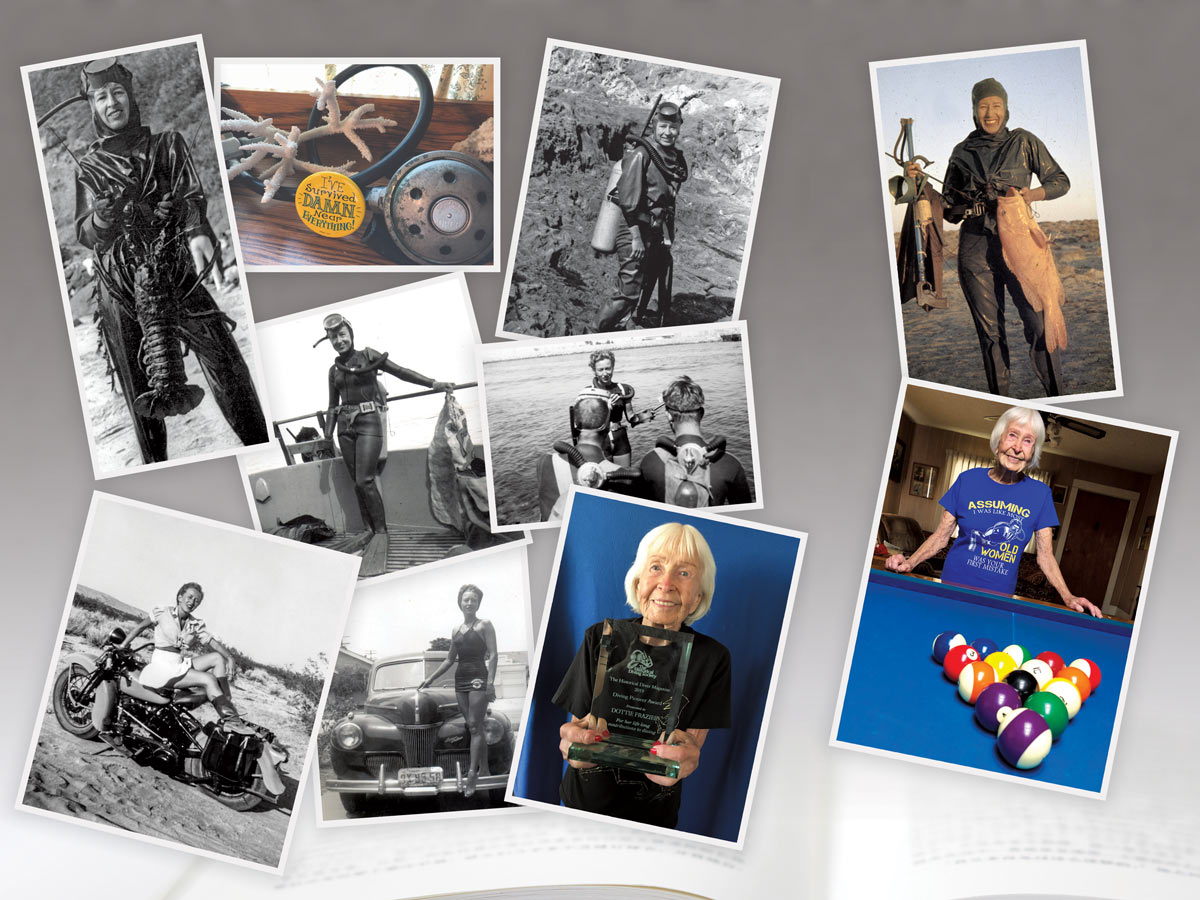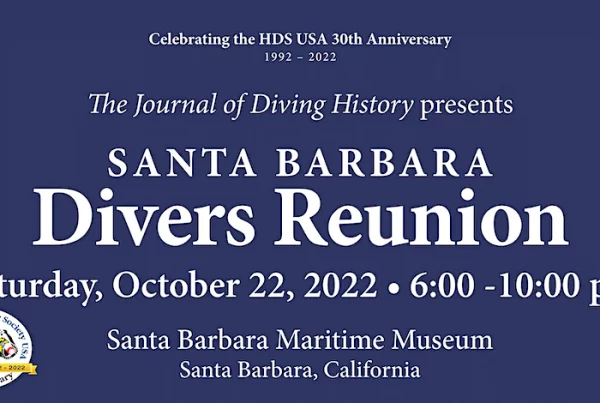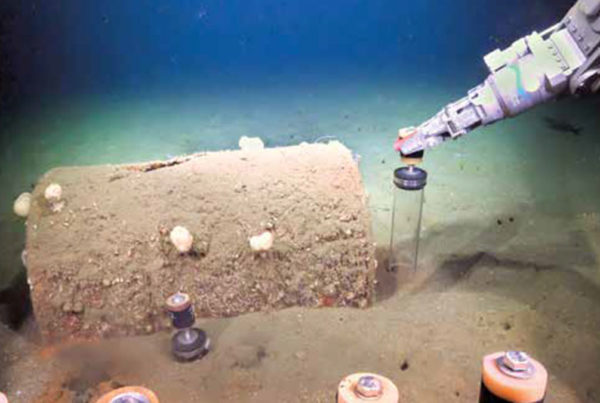Walking into Dottie Frazier’s home was like entering a museum: the walls and surfaces filled with framed awards and certificates, diving and maritime artifacts, treasured seashells, photos of her sons and grandchildren, diving friends, and much, much more, from surfing and motorcycles to sports medals won during her long and adventurous life.
And Dottie could tell a tale about each and every treasured memory: where she took that prize-winning fish, when she was given the ship’s bell, who she was surfing or diving with on the Mexico trip, and what motorcycle she rode on the desert trip.
Dottie passed away February 8, 2022, at her Long Beach, Calif. home, at age 99. She lived in her home for more than 80 years, purchasing it in the early 1940s with money made working on commercial fishing boats.
In her mid-90s Dottie started giving some thought to her collections, type-written tales (with carbon copies!) and other memorabilia. A book, she reasoned, would help secure her legacy as a diving pioneer and female trailblazer. Additionally, it would serve to organize and digitize her collections of images, scrapbooks and stories.
That’s when friends offered to help. “Dottie was concerned that after she passed away, her family would not know what to do with all of her scrapbooks, photos and stories,” recalls Bonnie Toth, one of Dottie’s sea sisters in the Women’s Divers Hall of Fame. (Dottie was inducted into WDHOF in 2000.)
Bonnie, always busy with graphic design projects for clients up and down the SoCal coast, stopped by Dottie’s as often as possible when in the Long Beach area. “I had been over there visiting and we got to talking. I told her I could design her book, but we would need someone to edit the stories.” That’s how Karen Straus, another WDHOF sea sister, became involved as the book’s editor.
Birth of a Book
But how is a self-published book like Trailblazer: The Extraordinary Life of Diving Pioneer Dottie Frazier actually born? How do boxes and boxes of papers and stacks and stacks of photo albums, collected over a long lifetime, become a professionally designed, edited and published book?
In Trailblazer’s case, the process was made easier by our collaboration with Dottie, a born storyteller, journal-keeper, poet, scrapbooker and collector. And she knew exactly what she wanted: for her voice to be authentic.
Dottie had already been contacted by another writer before Trailblazer was hatched, recalls Bonnie. “She was approached originally by an author in England who wanted to do a children’s book, which she had done previously for another well-known woman. But when she sent a first draft, Dottie responded by saying that the character did not sound at all like her, it made her sound like a girly-girl.”
At just 5 feet tall and 100 pounds, blonde and vivacious, you might easily mistake Dottie for a “girly-girl.” But that would be your first mistake, as Dottie would no doubt be delighted to inform you. Yes, she had modeling assignments and appeared in a film or two, but in the 1940s she was also a competitive spearfisher in a male-dominated sport, a founding member of the Long Beach Neptunes Spearfishing Club in 1950, a commercial fisher, an avid snow- and water-skier, surfer, hunter and motorcyclist. Later in life she was won Senior Olympics sports medals for racquetball and billiards. And don’t forget ziplining. Up to the age of 95 she celebrated birthdays with a zipline ride.
Most importantly, Dottie was an educator. From swimming instruction at the Long Beach Pike Plunge pool and YMCA skin diving classes in the 40s, to teaching all levels of Red Cross water safety programs, from small craft to lifesaving to first aid, up into the 1970s.
Most famously, she became the first woman in the US certified as a scuba instructor. She blazed this trail in 1955 when she applied for the Los Angeles County Underwater Instructors Course, 4 UICC. Having mailed in her application and course fee, she received in return a letter saying that the class was for men only. A male diving friend registered for the class told Dottie to show up anyway, because they had not returned her check. He drove Dottie to the class, coaching her on scuba physics along the way. Dottie took her seat in the classroom and the rest was history. She graduated second in the class and was asked to develop programs for female divers. She was also offered a seat on the Los Angeles County Underwater Unit board of directors, serving from 1956 to 1973. Over a 20-year period she taught scuba to hundreds of people.
Dottie was also the first woman to own and operate a dive shop, Penguin Dive Shop in Long Beach, and the first woman to manufacture wetsuits, not only for her own label, Penguin, but also for other manufacturers and the military.
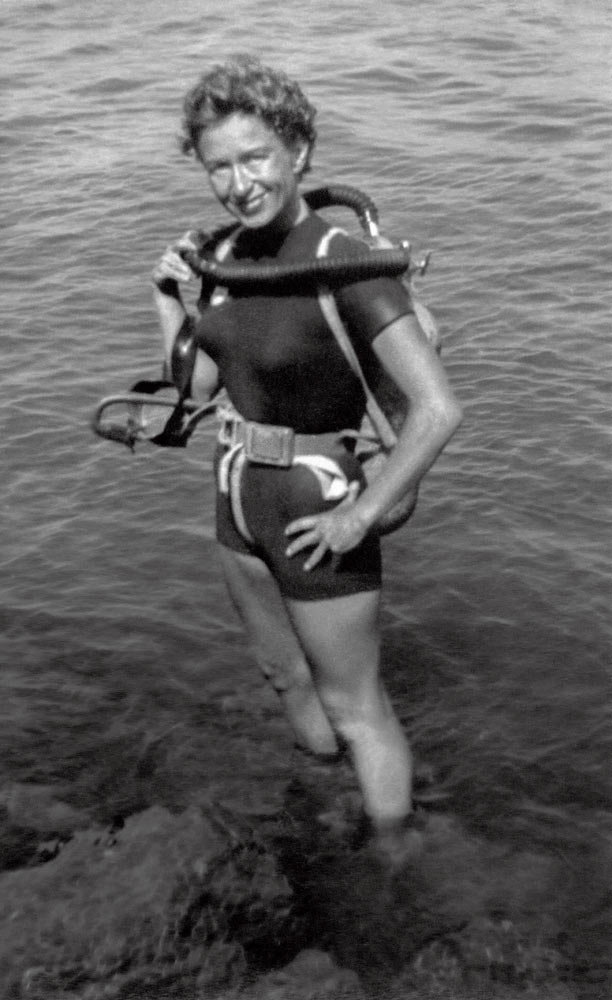
1954. Dottie in the water. (Photo courtesy of the Frazier family)
Freeway Flyers
But back to the book. With the editor in San Diego, the designer in San Clemente and Dottie in Long Beach, freeway flying to meet at her home was the next step. We met many times with her to record interviews, take notes, to photograph her and the artifacts, and to sort through and to digitally archive photographs and printed materials.
We also took boxes and boxes away to our homes, Bonnie the photographs and documents and me the typed stories. At our homes we did more processing and cataloging, digitally securing important art and papers for future use, before returning the materials in their boxes to Dottie. Bonnie scanned more than 500 photos, newspaper clippings, certificates, awards, etc., from Dottie’s scrapbooks.
With the digitizing and interviews complete, the designing in San Clemente and the editing in San Diego took place over the better part of a year. Periodically we drove to Long Beach to review book chapters with Dottie. The review process worked best for us by assembling printouts of completed chapters into a three-ring binder. We would leave the binder with Dottie to read, then meet with her to go over notes and suggestions.
After agreeing on a book title, it was now time to begin the administrative tasks associated with publishing a book. We did these tasks ourselves. If you prefer, book publishing platforms such as IngramSpark and KDP (Amazon’s self-publishing platform) can, for a fee, help you navigate the book publishing process. You fill out online data fields for items such as Library of Congress Control Numbers and ISBNs, and use online templates to design your book. At the end of the design process, you create a press-ready PDF file that is ready for printing.
Self-publishing services can also help you to determine the price of your book, keep track of your earnings (royalties), expenses and sales taxes; promote your book, sell your book on platforms such as Amazon, and fulfill book orders by printing on demand and shipping your book to buyers. You can also order books shipped to you to sell yourself.
Title search
There are many search engines online to look for book titles. Enter the title you are considering to see if the title is already in print. Titles cannot be copyrighted in the US. But if you use a title that is the same or very similar to another book, it makes it harder for your title to stand out.
Copyright
Copyright protects original works, including “literary, dramatic, musical, artistic, and certain other intellectual works.” Work is automatically copyrighted at the time of creation; however, registration is required if a business wants to sue over the use of the material by another party. To register your copyright online visit the US Copyright Office at copyright.gov.
Library of Congress Control Number
Library of Congress Control Numbers are preassigned to works that may be selected and cataloged by the Library of Congress for its collections. For more information, contact the Library of Congress at loc.gov/publish/pcn/.
ISBN number
The US ISBN Agency, Bowker, (not the Library of Congress) is responsible for assigning ISBNs to publishers resident in the US and who publish titles in the US. ISBN stands for International Standard Book Number. For more information visit Bowker at bowker.com/en/products-services/isbn-us/.
Ready to Print
Finally, you are ready to print. No surprise, there are more decisions to make before you can get printer quotes and a print date for your book.
- Determine the number of pages your book will have. This is based on your design and the number and length of chapters and the number and size of art elements that are flowed into the design template.
- Choose the size of your book, called the trim size. This means the height and width of the pages of a book, anything from a small gift book to a paperback to a large coffee table picture book.
- Choose color or black and white or a mix of both. Color increases cost.
- Choose the paper type and weight, both the cover and the inside pages. Paper is also called the stock, and the weight or quality impacts your print costs.
- Choose a cover style: hardcover, hardcover with dust jacket, softcover, quality paperback.
- Choose a binding: case binding, perfect binding, saddle stitch binding, comb, spiral and thermal binding.
A Word on Words
Dottie asked several times to “just add one more story” to the book. We explained that any additions to the book needed to fill a signature, or a set of pages printed as a unit. For example, a piece of paper folded in half is called a folio. A signature consists of folios, papers folded in halves or quarters (quartos), that will be cut to form pages.
A signature is usually made up of a group of folios, usually three or four, resulting in 12 to 16 pages. If you add additional pages to a book, you must add them in a signature and you must have enough additional manuscript or art material to fill the signature, which could be 12 to 16 pages, depending on how many folios are in the signature.
And no surprise here, the printing price increases with every additional signature that is added to the book, and potentially, your shipping costs as well. When Bonnie priced out adding an additional signature to Trailblazer, we all quickly agreed to keep the book at a more affordable 112 pages. Plus, it was more tightly edited, the most compelling stories already included.
The birth of a book was an exciting year for all of us. For Bonnie and myself, it was especially enjoyable to visit Dottie with designed chapters in the binder and seeing the sparkle in her eye as she relived the memories. As often as not, she regaled us with additional stories not yet committed to paper. She always prepared lunch for us: grilled cheese or tuna, Jell-O made with fruit cocktail and a square of cake.
We were both so very gratified that Dottie lived to see her book in print, Trailblazer: The Extraordinary Life of Diving Pioneer Dottie Frazier, which was published in August 2019 by Frazier Publications. That same year Dottie was honored with the Historical Diving Society’s 2019 Diving Pioneer Award. She loved signing copies of the book for her legions of fans, some coming to diving events at which she was honored, others visiting her at home.
Dottie will be greatly missed by many, but her book, accomplishments and stories live on. She was a pioneer for all divers, and a bright beacon for all the female divers following in her wake.
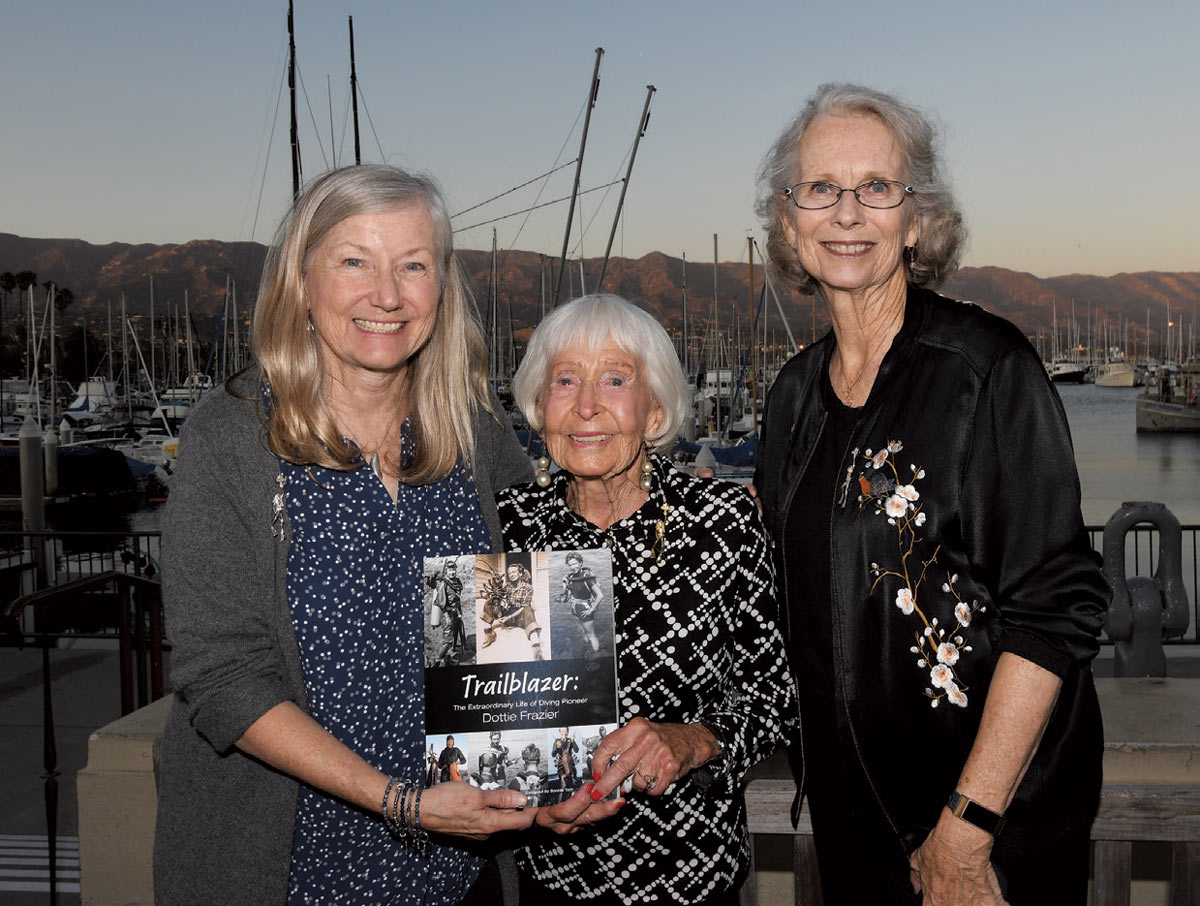
Bonnie Toth (designer), Dottie Frazier and Karen Straus (editor) in Santa Barbara in 2019 (Photo Bernie Campoli)
About the authors
Bonnie Toth (Women Divers Hall of Fame 2007) served as designer and Karen Straus (Women Divers Hall of Fame 2011) as editor of Trailblazer: The Extraordinary Life of Diving Pioneer Dottie Frazier. Previously, Bonnie and Karen collaborated with Eric Hanauer on Immersion: 75 Years of Discovery and Adventure, a privately published coffee table book on the 75th anniversary of the development of the aqualung and a history of the Aqua-Lung company. Bonnie serves as managing editor of The Journal of Diving History. Karen is a contributing editor/photographer for Dive Training magazine and California Diving News.

